With legalization happening in more places, it’s increasingly easy to purchase substances like shatter – marijuana concentrates that are extremely potent. Translucent and glass-like, shatter is growing in popularity among cannabis consumers. What is marijuana shatter and how are these kinds of concentrates different from traditional cannabis?
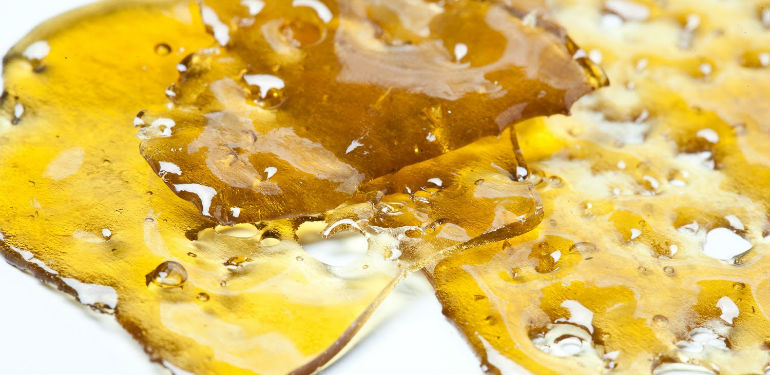
How does cannabis shatter differ from regular marijuana flower?
What Is a Concentrate?
Cannabis concentrates like shatter, wax, honey oil, and others provide a different and much more powerful high than basic flower. They’re essentially cannabis that has been put through a process to extract and concentrate the desired chemicals – namely, cannabinoids such as THC (tetrahydrocannabinol) and CBD (cannabidiol), as well as terpenes.
For recreational consumers, the ideal finished concentrate is potent and packed with high-inducing THC. When it comes to shatter, THC levels can run as high as 80%. Some cannabis oil concentrates are very low in THC and high in CBD; shatter with higher CBD ratios is often used for medicinal purposes.
How Are Shatter Marijuana Concentrates Made?
Making shatter requires a solvent such as CO2 or butane. To make butane hash oil (BHO), CO2 shatter, or wax, manufacturers put cannabis plant material in a holding container and force a solvent through it order to extract the cannabinoids.
The process is a rather dangerous one that requires knowledge about how to properly handle the chemicals being used. Emboldened by do-it-yourself YouTube videos, novice BHO manufacturers have caused explosions, fires, and injuries by using improper equipment and extraction methods. CO2 extraction is a safer process that uses more natural ingredients.
After the extraction process, the result is an extremely strong substance that has much more THC than traditional cannabis. Its consistency varies: a cannabis concentrate can be an oil, a soft, smooth substance known as budder, a malleable, crystallized material known as wax, or shatter—an amber-colored, glasslike form of hash oil.
These are all commonly known as “dabs,” and the typical method for smoking these materials is known as “dabbing.”
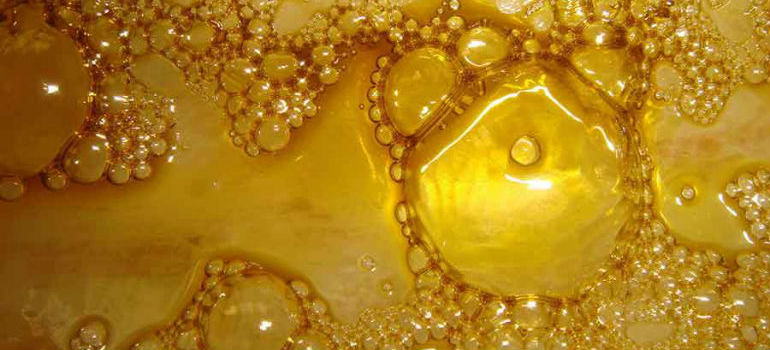
Pull-and-snap, wax, and shatter all start out as a soft and runny cannabis concentrate.
Wax vs Shatter: What’s the Difference?
With all of the various marijuana concentrates available, many people are left wondering the difference between wax or crumble vs shatter. The main difference is the consistency. When it comes to shatter BHO and other concentrates, the finished result can be runny and gooey (honey oil), waxy (wax and crumble), taffy-like (pull-and-snap), or hard and glasslike (shatter).
The final consistency of concentrates depends on the flower material the manufacturers used, with some marijuana strains rendering softer concentrates and others hardening up rather easily. Manipulation and processing can also create shatter vs crumble, but regardless their form, all concentrates end with high levels of cannabinoids, making them incredibly potent.
Experienced BHO manufacturers put shatter through a purification process that strips out the wax, fat, terpenes, butane, and other materials that remain in other concentrates. This process takes out a lot of the flavor that remains with other BHO concentrates but makes the final product a lot stronger.
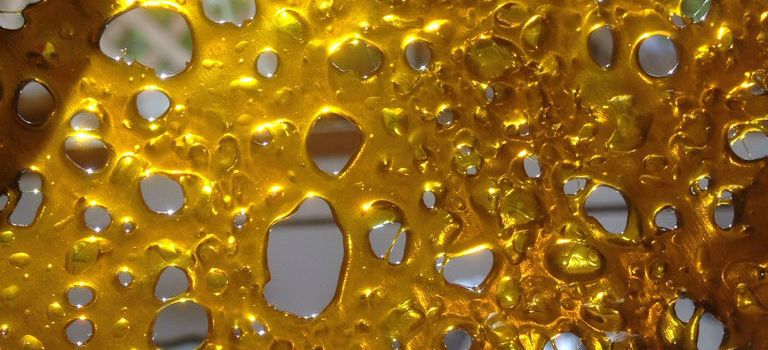
Shatter marijuana concentrates are hard and glass-like in consistency.
Smoking Shatter
From pull-and-snap to crumble, wax, and shatter, smoking dabs requires a dab pen, a dab rig, or a water pipe modified for the purpose of dabbing.
Because dab pens are small, discrete, and inexpensive, they’re accessible to most who would like to try concentrates. One of the big problems with vaporizers, however, is that with underpowered heating elements and puny batteries, they often don’t get the concentrates hot enough. This can affect the size of each hit, as well as the overall flavor of the smoke.
The most popular way to smoke shatter, wax, and other concentrates is dabbing. This requires a dab rig, a specialized device with a metal “nail” or glass banger attached to a water pipe.
Smoking shatter marijuana concentrates requires a source of intense heat to vaporize the material. Many people like to use a handheld torch to heat up the nail where the dab will be placed. Electric nails, or e-nails, eliminate the need for an open flame (and cut down on the risk of burns and fire).
First-time dabbers tend to take a hit and hold in the smoke the way they would for a bong or joint hit. This isn’t necessary for dab hits, though, and will cause lung irritation. The best method is to exhale before taking a hit and then inhaling the smoke before blowing it right back out again. Smaller inhalations work best for those who are prone to coughing.
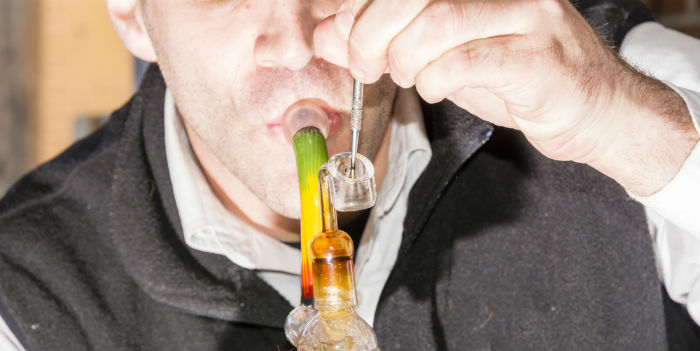
Fans of shatter, wax, and other concentrates usually smoke them in specialized dab rigs.
Shatter Effects
Because smoking shatter doesn’t involve breathing in combusted plant material, the high generated by marijuana shatter is often described as “cleaner” than other inhaled methods of consumption. This cleaner and more consistent high is why many marijuana connoisseurs are switching to lab-manufactured concentrates. For cannabis consumers hoping to ingest large amounts of THC, shatter provides high concentrations of this and other cannabinoids. While a particularly potent strain of flower may have THC levels that run at around 25 to 30%, the THC content of shatter can be a staggering 80%.
In other words, shatter causes an intense high incredibly quickly. A single hit of high-THC shatter is more powerful than smoking an entire joint. This can create immediate intoxication, couch-lock, dry mouth, and a feeling of heaviness and relaxation.
Storing Shatter
The first consideration when manufacturing shatter is purity, and proper handling and storage will ensure that a high-quality shatter concentrate will stay clean and free of debris. This is especially true of medicinal concentrates, as patients don’t want to medicate with shatter that’s been contaminated with dirt or bacteria.
To keep shatter marijuana concentrates as clean and pure as possible, consumers should always handle them with gloves or parchment paper. This will keep the shatter free of any oils or bacteria that may be lurking on their hands. Always place concentrates on a nonstick surface to avoid wasting the sticky residue that often remains when they’re picked up.
No matter how it’s stored, shatter will eventually start to soften and turn into budder. This will happen faster if it’s kept at room temperature or exposed to heat. To slow this process, it should be stored in an airtight container in a cold, dark environment. There are non-stick containers manufactured specifically for crumble, wax, and shatter, as well as other concentrates. An airtight glass jar will work in combination with parchment paper to keep the shatter from sticking to the glass.
For freezer storage, it’s advised to use parchment paper to separate individual dabs for easy portioning. Condensation can be a problem with storing shatter in the freezer. Moisture will cause it to break down faster. The storage container must be wiped dry to prevent the formation of condensation.
Shatter and other cannabis concentrates should be kept clean and dry in something like this silicone storage container.
Potential Risks of Smoking Shatter
Due to the ingredients used during the manufacturing of concentrates, as well as the incredible potency of the finished product, products like shatter come with a certain degree of risk. Here are the issues that cannabis experts highlight as concerns.
Impurities
Besides the risk of explosions inherent with home production of solvent-based concentrates, one of the biggest concerns with shatter, wax, or other concentrates is impurities. When manufacturing shatter, butane and other solvents are supposed to be flushed out. Whether the finished product is BHO or CO2 shatter, it’s impossible to discern the purity of a concentrate by simply looking at it. The only way to tell how much butane remains in a concentrate is to lab test it.
Ingesting solvents and other contaminants in concentrates is dangerous – especially for people who have compromised immune systems and are using concentrates for medical purposes. The internet is full of discussions about tainted BHO and threads where people complain about ending up with “tane soup”—unpurged BHO that smells and tastes of butane.
Overconsumption
Even with pure cannabis shatter, first-timers should proceed carefully due to the high levels of THC in some concentrates. While there have been no documented deaths from a THC overdose, overdoing it can create a highly unpleasant experience. Over-consuming THC can result in an elevated heart rate, feeling anxious and disoriented, shortness of breath, nausea, vomiting, and paranoia. Those predisposed to mental illnesses such as schizophrenia and anxiety disorder are especially prone to negative side effects from ingesting high levels of THC.
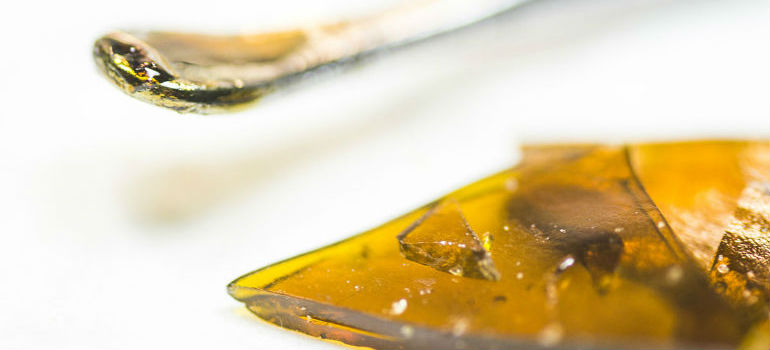
Due to high percentages of THC, shatter raises the risk of unintentional overconsumption.
The Medical Uses of Shatter
Because of its high level of THC, shatter is an extremely useful treatment for a variety of medical conditions.
Nausea and Appetite
At the proper doses, THC-rich shatter works well to quell nausea and vomiting. It’s also an effective appetite stimulant. This makes it especially helpful for those who patients who are undergoing treatment for cancer, as well as people who are experiencing wasting as a symptom of HIV/AIDS.
Muscle Spasticity
THC has been studied as an effective treatment for the symptoms of multiple sclerosis. These include muscle spasticity and pain. In fact, nabiximols/Sativex is a THC-derived medication that has been licensed for use in MS patients.
Anxiety and Depression
Some types of shatter are high in CBD, a cannabinoid that’s excellent at treating mood disorders. Among the conditions that CBD shatter helps are anxiety and depression.
Pain
Both high-potency CBD and THC shatter are powerful forms of marijuana for pain relief. Shatter can be helpful to those who suffer from migraines, back pain, arthritis, fibromyalgia, and any number of other painful conditions.
Controversy over Shatter Marijuana Concentrates
Although shatter, BHO, and other concentrates have a fierce following, they are still controversial both in the news and among cannabis traditionalists. This is due to several factors. The explosions and fires caused by novices attempting to make BHO at home have been the focus of shocking and frightening headlines. There is also the risk of negative side effects experienced by those who overconsume – particularly those who aren’t familiar with the potency of products like high-THC shatter. Emergency room visits and psychotic episodes figure heavily in news coverage of concentrates.
Even many longtime cannabis connoisseurs are suspicious of products like shatter, partly due to their strength, but also because the entire dabbing experience doesn’t resemble any of the traditional ways of smoking marijuana. Using a torch to heat up the nail reminds people of paraphernalia used to do harder drugs. In addition to this, the crystal-like appearance of shatter has caused people to question whether it’s the “crack” version of marijuana.
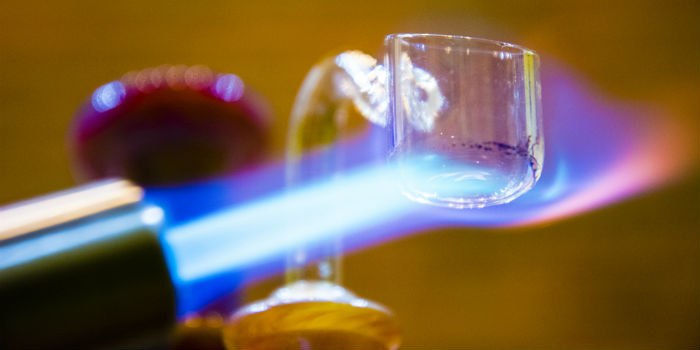
The equipment used to smoke shatter – and even the substance itself – reminds many cannabis traditionalists of hard drugs.
Shatter FAQ
With so many different consistencies, strengths, and strains available, concentrates like shatter generate many questions. Here are some of the most common topics people ask about when learning about shatter marijuana concentrates.
What is shatter?
Shatter marijuana is a concentrate created when solvents are used to separate essential compounds such as cannabinoids and terpenes away from the plant material. High-THC shatter creates intoxicating effects that are stronger than marijuana flower. As its name implies, shatter is glass-like and can be broken into pieces.
How is shatter made?
Production of shatter, wax, and other concentrates requires use of a solvent to strip cannabinoids and terpenes away from marijuana flowers. With CO2 shatter and BHO concentrates, the final product should be nearly free of any residual solvent. Consistency of concentrates depends on strains used and variations in processing.
What’s the difference between wax and shatter?
The difference between shatter and wax is consistency. Both are highly potent cannabis concentrates that are smoked to get immediate and intense effects. Wax is softer and more pliable, while shatter marijuana concentrates are like glass – translucent, harder, and breakable when dropped or banged against a hard surface.
Can you eat shatter?
Yes, but results will vary based on whether the shatter is decarboxylated and how it’s consumed. Decarboxylation involves heating marijuana to activate its cannabinoids and is required to generate a high. Shatter must be consumed with oil or fat in order for the cannabinoids to absorb in the digestive tract.
The Push for Education About Shatter
Despite the controversy, shatter and other concentrates are growing both in popularity and in availability. While places like the Netherlands have been hesitant to legalize concentrates, consumers can find shatter, wax, budder, honey, and oil at medical and recreational dispensaries throughout the U.S. This means that cannabis tourists can easily stumble upon this relatively new way of enjoying marijuana and not realize its strength.
With so much misinformation floating around regarding concentrates, as well as cannabis in general, there is a push from the cannabis community to educate people about marijuana safety and consuming responsibly. This will make it easier for people to acquire concentrates that are pure and were manufactured under professional, safe conditions. It will also ensure that whether they’re using concentrates like shatter for medical or recreational purposes, novices know how to proceed cautiously – ensuring that their experience with oil, wax, and shatter marijuana concentrates is a positive one.
Category Pages:
- Concentrates & Extracts - A 101 guide to cannabis concentrates & extracts from BHO and beyond.
- BHO (Butane Hash Oil) - A guide to the basics of butane hash oil – from its effects to ingestion methods.
- Bubble Hash - A guide to bubble hash: how it differs from other concentrates, how it’s made, how to use it, and why it’s so popular.
- Cannabis Shatter - (CURRENT PAGE)
- Hashish - A 101 guide to hash – from making and smoking hash to its effects.
- Kief - A look at how to extract and decarboxylate kief, its effects, and what to do with kief.
- Cannabinoids - Exploration of cannabinoids, their effects, and their health benefits.
- Cannabis 101 - Information about cannabis life, culture, and consumption methods.
- Cannabis Types - A guide to the different types of marijuana: sativa, indica, hybrids, hemp, and ruderalis.
- Cannabis & Health - A guide to the many benefits of marijuana, including medical and general health uses.

 Author: Jason Oliver
Author: Jason Oliver